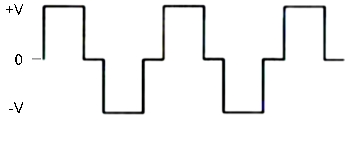
| June 7, 2023 | |||
Is a modified sine wave inverter bad for laptop adapters and other switchmode power supplies? |
|||
Statement of the problemThe most inexpensive way to create AC from DC is with a modified sine wave inverter. This is because the transistors in the H-Bridge are always all-the-way on, or all-the-way off. This means that the transistors are operating at their lowest power dissipation. It also means that the power rating of the semiconductors and the size of the heat sink can be minimized.The waveform looks like this:  This waveform differs from a square wave by having a gap at zero volts on every zero crossing. This has the effect of throwing more power into the fundamental frequency without losing power in the switching transistors. This makes it easier on motors than a pure square wave, but they still suffer from about 30% of the power being dissipated as heat. So motors and compressors shouldn't be run on modified sine wave. Motors and compressors will run, just not as efficiently. You might look at this as a very bad approximation of a sine wave, but it is hands-down better than a square wave. Switching power suppliesSo what effect does the modified sine waveform have on modern switchnmode power supplies, such as laptop adapters? Well, it turns out that the first thing that a modern power supply does is rectify the AC to DC and filter it. When you are using a pure sinewave source, the full-wave rectified waveform looks like this: You can see that a lot of filtering has to be done in order to make this like the DC. Here is an example of using a capacitor to smooth out the pure sine wave.  This is what a modified sine wave looks like when full-wave rectified:  Here is my idea of what the modified sine wave would look like when filtered by a capacitor. It doesn't include the effect of the RC time constant, which would round the edges.  As you can see, the "DC" from a modified sine wave is maybe even better than the sine wave version. The switching circuit in a SMPS power supply can use this just as it can use a sine wave, without loss of efficiency. What about power factor corrected power supplies?Larger power supplies are typically power factor corrected. Power Factor correction tries to draw a sine wave from the mains, to prevent distortions in the mains supply. There are a number of ways to do this and I haven't yet evaluated the effect on a modified sine wave "mains." What I do know is that in the 23 years I have been in the power supply business I haven't heard any complaints of short life, nor have I seen modified sine wave inverters or the power supplies they are driving face premature failure. What about audio noise?I have heard complaints about audio noise on laptop audio systems due to the harmonics present in the modified sine wave. The power supplies themselves usually filter this out, and well designed audio circuits are very immune to noise on the power input, but it sometimes happens. |
|
|
|
| |||||||||